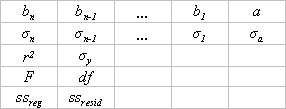Documentation/How Tos/Calc: LINEST function
From Apache OpenOffice Wiki
LINEST
Returns a table of statistics for a straight line that best fits a data set.
Syntax:
LINEST(yvalues; xvalues; allow_const; stats)
- yvalues is a single row or column range specifying the y coordinates in a set of data points.
- xvalues is a corresponding single row or column range specifying the x coordinates. If xvalues is omitted it defaults to 1, 2, 3, ..., n. If there is more than one set of variables xvalues may be a range with corresponding multiple rows or columns.
- LINEST finds a straight line y = a + bx that best fits the data, using linear regression (the "least squares" method). With more than one set of variables the straight line is of the form y = a + b1x1 + b2x2 ... + bnxn.
- if allow_const is FALSE the straight line found is forced to pass through the origin (the constant a is zero; y = bx). If omitted, allow_const defaults to TRUE (the line is not forced through the origin).
- LINEST returns a table (array) of statistics as below and must be entered as an array formula (for example by using Cntrl-Shift-Enter rather than just Enter)
- If stats is omitted or FALSE only the top line of the statistics table is returned. If TRUE the entire table is returned.
- b1 to bn are the line gradients; a is the y-axis intercept.
- σ1 to σn are the standard error values for the line gradients; σa is the standard error value for the y-axis intercept.
- r2 is the determination coefficient (RSQ); σy standard error value for the y estimate.
- F is the F statistic (F-observed value); df is the number of degrees of freedom.
- ssreg is the regression sum of squares; ssresid is the residual sum of squares.
Example:
to follow
